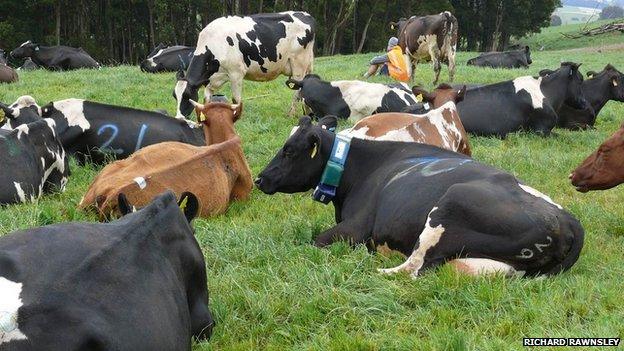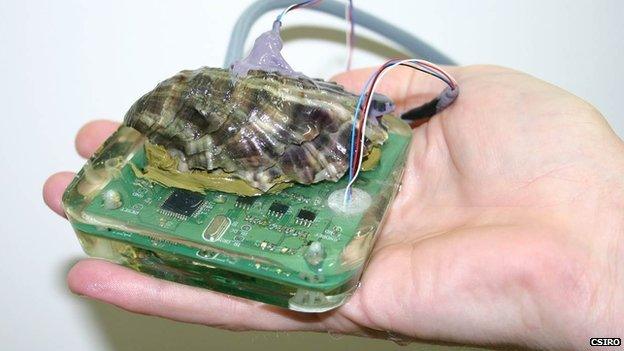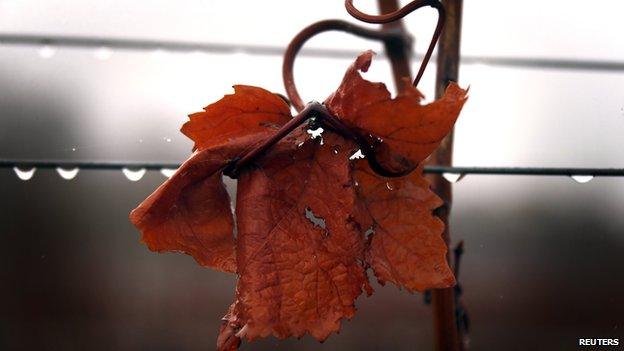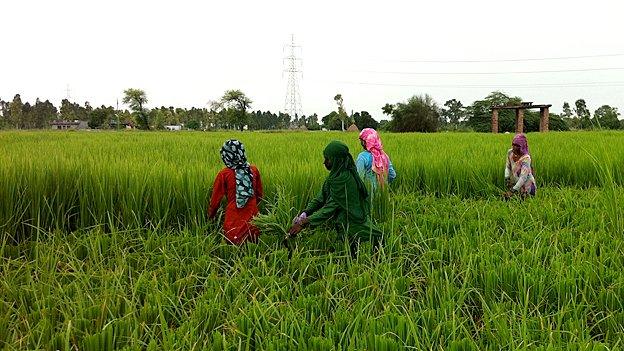How technology is transforming Tasmanian farms
- Published

An oyster's reaction to changing water conditions could indicate pollution and other hazards
Tasmania has become a "living laboratory" that is unlocking the secret lives of cows, monitoring stress levels among oysters and warning vineyards of disease and frost to help boost farming on Australia's Apple Isle.
Dairy herds have been fitted with electronic collars that indicate when they are ready to breed and the amount of time they spend walking and grazing, while bio-tags attached to oysters measure their heart rate.
The aim is to chart the health of animals and plants along with the efficiency of farms as part of an initiative dubbed "Sense-T" that is creating a state-wide network of sensors to give producers, and ultimately consumers, detailed information about Australian produce.
The project is a collaboration between the University of Tasmania, the Tasmanian government, the Commonwealth Scientific and Industrial Research Organisation (CSIRO) and computer giant IBM.
"The concept is that it is a living laboratory to create a digital view of the whole economy, to be able to get an economy-wide sensor and data system," said Jen Makin, programme manager for Sense-T at the University of Tasmania.
Applications to improve the workings of the freight and logistics industry are also being pursued, along with tourism and health.

Could modern technology revolutionise farming methods in Australia?

Consumers in Australia could soon be able to track where their groceries came from
'From farm to front door'
Ultimately, the scheme could track produce from the farm gate to the front door, and allow shoppers to swipe their smartphone over packaging to discover where their food comes from, who processed it and how it was transported and stored.
"It would allow them to see the conditions under which their food is produced, the environmental impact of that and the way that it has been handled along the way," Ms Makin said.
They don't know it, but dairy cows wearing electronic collars in northern Tasmania are part of a wireless experiment aimed at enhancing milk production and detecting when the animals are on heat to ensure successful artificial insemination.
"There is a whole part of the day [in which] we don't know what the cows are actually doing," said Richard Rawnsley from the Tasmanian Institute of Agriculture.
"We have made some significant breakthroughs in technology that have helped us better understand what is out in the field, and now it's about exploiting that. It will certainly lead to enhanced efficiencies and help farmers make sound, sustainable decisions," he explained.
The sensors generate a colossal amount of information, and complex algorithms are used to crunch the numbers to give practical advice to farmers about when, for example, it is best to feed grain or supplements to their stock, and which animals may need more food.
Anomalies found in the data could also be an indication of health problems among the herd.

The oysters are fitted with sensors to detect heart rates and environment changes
Molluscs
Oysters, too, are part of this unprecedented Tasmanian trial.
Tiny holes are drilled through their shells and a probe gently inserted detects changes in the oyster's heart beat. The probe is linked to an external sensor.
"The aim for us is to correlate the information we get back from the heart rate to all the various environmental cues to see whether we can actually predict and monitor how the oyster is behaving to the changes in the environment," said Dr Nick Elliott, a research scientist with the CSIRO who leads a group of aquaculture experts.
The oysters then sit on a submerged platform loaded with various electronics that measure the amount of photo-plankton in the water, and the water's temperature and salinity.
Like canaries in coal mines, the molluscs' reaction to changing water conditions could be indicators of pollution and other hazards.
"When you are farming in aquaculture it is very difficult to observe the animals you are growing. What we are looking at is having what we call sentinel animals on the farm that are providing information back to the farm managers," Dr Elliott explained.

Rising temperatures from climate change could affect harvest periods at vineyards

Anti-frost technology has helped grape farmers like Matthew Pooley (pictured) to continue operations
In the Coal River Valley, northeast of Hobart, the digital experiment is helping winemakers challenge two of their greatest foes: frost strike and disease.
An increase in demand for Riesling and Pinot Noir has forced Matthew Pooley, a third generation grape grower in southern Tasmania, to plant in more frost-prone areas.
A series of sensors now orchestrates irrigation and sprinkler systems that are used to prevent or mitigate the effects of the cold, harsh conditions.
"We've got sensors in the vineyard that, through a computer system, can activate the pump and automatically turn on the frost protection system," said Mr Pooley.
The efficient use of anti-frost software helps growers avoid the ground getting water-logged, which can cause disease.
Other gauges assess wind speed, rainfall, soil, air temperature and relative humidity.
"We are going into a drier and drier environment so I need to be able to manage our production differently from 15 years ago," he says. "It allows me to become more efficient."
- Published18 September 2014
